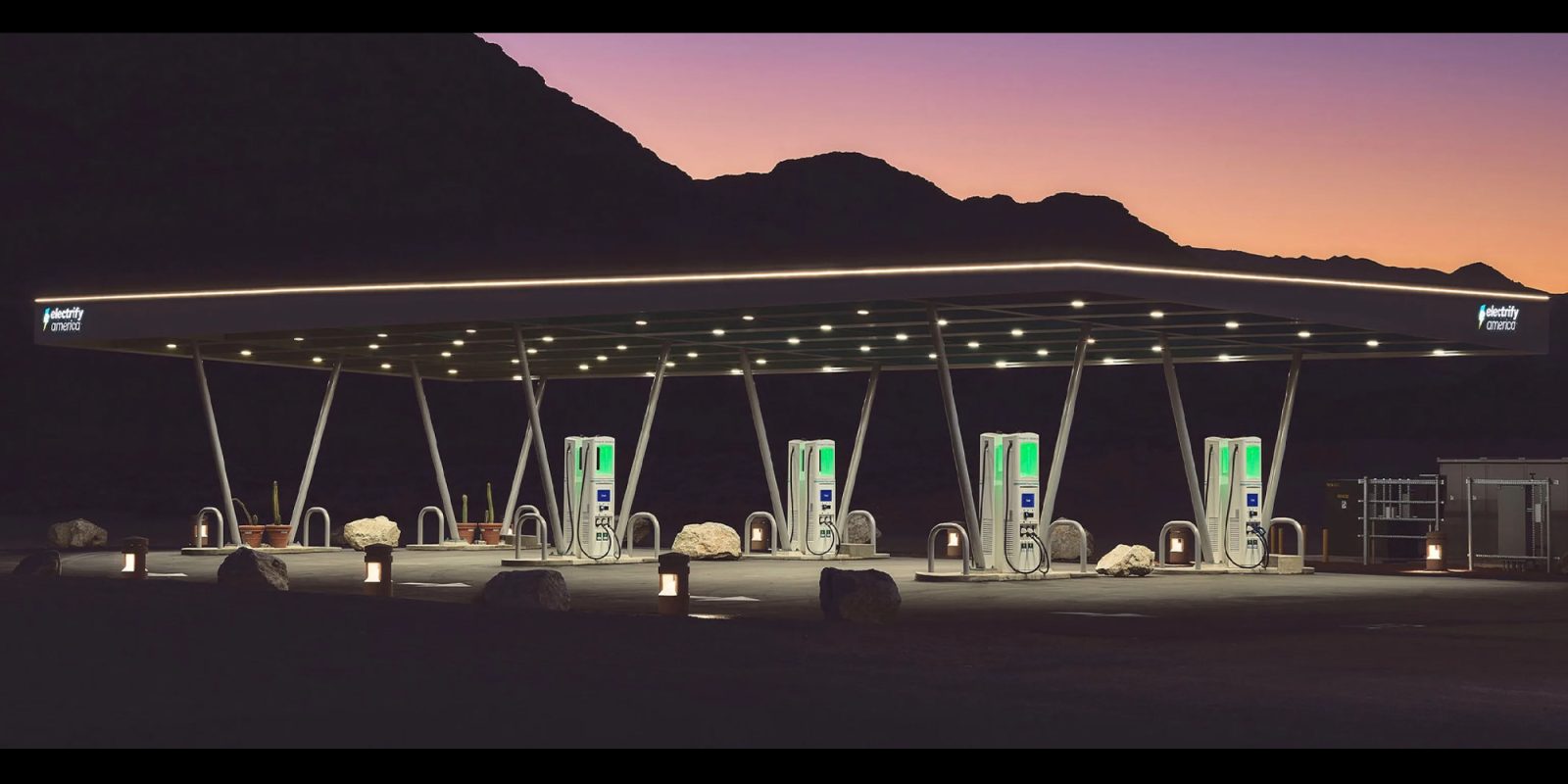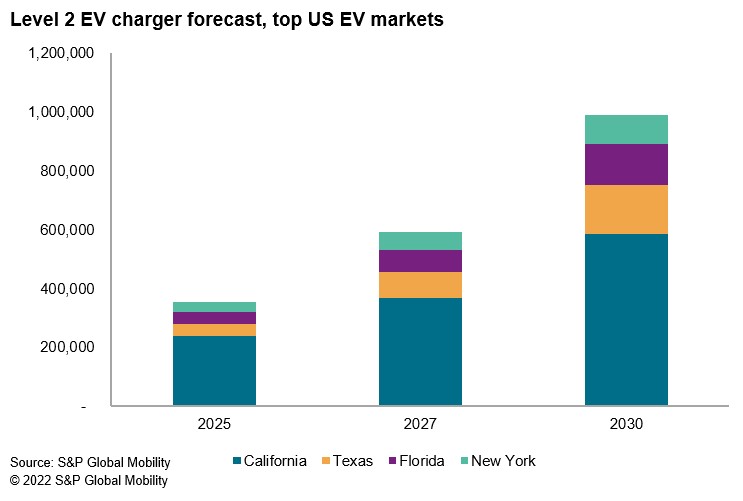
There are currently more than 160,000 EV chargers in the United States. Here’s how many the auto industry data analysts at S&P Global Mobility think the country will need to install by 2030.
How many EV chargers the US has
S&P Global Mobility estimates that there are presently around 16,822 Tesla Superchargers and Tesla destination chargers in the United States, along with 126,500 Level 2 and 20,431 Level 3 charging ports.
The number of charging ports increased more in 2022 than in the preceding three years combined, with about 54,000 Level 2 and 10,000 Level 3 chargers added during 2022.
S&P Global Mobility says registration data shows that there are 1.9 million EVs on US roads – 0.7% of the 281 million vehicles in operation – as of October 31, 2022.
New light-vehicle registration share for EVs reached 5.2% over the first 10 months of 2022, and rapid growth is going to happen, thanks to consumer demand, US government policy that incentivizes EV purchases like the Inflation Reduction Act, and increasing interest and investment from the financial sector.
How many EV chargers the US needs
EV market share for new vehicles is likely to reach 40% by 2030, at which point the total number of EVs in operation could reach 28.3 million, according to S&P Global Mobility forecasts.
The group expects that there will need to be about 700,000 Level 2 and 70,000 Level 3 chargers deployed, including both public and restricted-use facilities.
So, in order to match the charging needs of all those EVs, the United States will need to quadruple the number of EV chargers between 2022 and 2025 and grow more than eight-fold by 2030, even taking home charging into account, according to the analysts.
By 2027, the analysts expect that there will be a need for about 1.2 million Level 2 chargers and 109,000 Level 3 chargers deployed nationally.
And looking to 2030, with the assumption that there will be 28.3 million EVs on US roads, a total of around 2.13 million Level 2 and 172,000 Level 3 public chargers will be required, in addition to home EV chargers.
Where EV chargers are going
As of September 27, 2022, all 50 states plus Washington, DC, and Puerto Rico have approved state plans under the National Electric Vehicle Infrastructure formula program [Updated January 18, 2023]. The Bipartisan Infrastructure Law has made available $5 billion over five years to be spent on EV charging infrastructure across the US. President Joe Biden has pledged that the federal government will pay for the installation of 500,000 chargers.
The four states with the highest number of EVs in operation and highest new-vehicle registrations traditionally are California, Florida, Texas, and New York.
Because these states all take a different approach to emissions reduction – that is, California and New York prioritize it and Florida and Texas don’t – S&P Global Mobility attributes this growth to the size of their markets.
California is in the lead by far, with nearly 37% of total EVs in operation and nearly 36% of total US light-vehicle EV registrations from Jan-Sept 2022.
Florida sits in a distant second with 7.4% of light-vehicle EV registrations and 6.9% of EVs in operation. Texas comes in at 5.8% of EVs in operation and 6.4% of EV light-vehicle registrations.

As an example of what is and what’s needed at the state level, Texas currently has about 5,600 Level 2 non-Tesla and 900 Level 3 chargers, but S&P Global Mobility forecasts that the Lone Star State will need around 87,500 Level 2 and 7,800 level 3 chargers to support the expected 1.1 million EVs in operation by 2027.
Eighty-five percent of Level 3 chargers and 89% of Level 2 chargers are currently located in the 384 US Metropolitan Statistical Areas (MSAs) as defined by the US Census Bureau. For Tesla owners, 82% of Tesla Superchargers and 83% of its destination chargers are in MSAs.
S&P Global Mobility analyst Ian McIlravey said:
The focus on urban areas follows where EVs are today, but distribution will need to be much wider as vehicles in operation grow, and consumers need to charge along their routes.
And Graham Evans, S&P Global Mobility research and analysis director, said:
For mass-market acceptance of BEVs to take hold, the recharging infrastructure must do more than keep pace with EV sales.
It must surprise and delight vehicle owners who will be new to electrification, so that the process seems seamless and perhaps even more convenient than their experience with gasoline refueling, with minimal compromise on the vehicle ownership experience.
Electrek’s Take
What the US really needs is an increase in the density of DC fast chargers, and the strategic location of said DC fast chargers in convenient, well-lit places.
It’s not useful to have hundreds of Level 2 chargers along an interstate. People who are road tripping need convenient fast chargers right off the road. (Oh, and to state the obvious, they need to be in working order.)
This is why Tesla Superchargers are great. Anyone who has used them on the New Jersey Turnpike, for example, knows what I’m talking about. You pull straight off, they’re in a conspicuous, well-lit area, and there are food and restrooms right next to them. They’re safe and convenient. Within 20 minutes you’re back on the road.
Compare that to my two-hour road trip last week from Boston to Vermont in my VW ID.4. Logan Airport has 6.5 kW EV charging ports in the parking garage. They’re free, and that’s nice, but you’re not allowed to leave your car plugged in while you’re traveling.
Top comment by Bob Anderson
I am baffled why there is so much focus on L2 charging. If you're a homeowner, you'll charge at home for commuting around town. For road trips, you'll use L3 charging. And if you're staying at a hotel, they will most likely have a L2 charger. If you are renting, hopefully, you'll find a place that has L2 chargers available, but if not, you can always quickly charge at a local L3 station.
But L2 at grocery stores and especially along highways for long-distance travel is useless, as the article mentions. Who wants to wait 5 hours in a parking lot waiting for a charge? This is why GMs 40,000 charger plan and the 500,000 chargers promised by the government are a waste of money (at least the L2 aspect). Thankfully Tesla has figured this out and spends money on chargers where it matters.
What in the hell are you going to do with a 6.5 kW charging port at the airport? Sleep in your car after you return?
Airports really ought to provide each EV parking spot with a Level 1 outlet that you can just plug your car into while you travel. That would be a dream.
So I drove to Somerville, just a couple miles from Logan, to a set of three 150 kW Electrify America charging ports. I had to put my credit card into the kiosk to get into the parking garage where they were located. I had to search for them. They were isolated, near no bathrooms, and it was 10 p.m. It was far from an ideal experience. Rollout of new EV charging ports needs to correct this situation.
UnderstandSolar is a free service that links you to top-rated solar installers in your region for personalized solar estimates. Tesla now offers price matching, so it’s important to shop for the best quotes. Click here to learn more and get your quotes. — *ad.
FTC: We use income earning auto affiliate links. More.





Comments